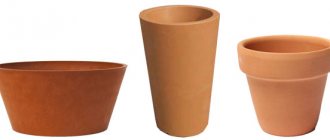The easiest way to get more plants is to cut and root cuttings. This way you will receive new planting material completely free of charge and as many rooted plants as you like with all the external characteristics of the mother specimen.
- Classification of cuttings Propagation of perennials by cuttings Propagation of perennials by leaf cuttings
- Propagation of perennials by stem and root cuttings
- Propagation of shrubs by direct or green cuttings
Balsam
Our grandmothers’ favorite plant always pleases with an abundance of bright flowers from white to red. Any sprig of balsam without flowers can be easily placed in water with an activated carbon tablet and after 5 days the first roots will appear.
Please note that the water must be settled and without chlorine. Next, the plant will take root well in the pot if you add loose, humus soil with potassium fertilizers.
Tradescantia
This cute climbing plant is very useful - it purifies the air in the house. Its striped shoots can reach several meters in length if left unpruned. The flowers are small and inconspicuous, mostly white, although there are species with lilac flowers.
Tradescantia propagates by rooting any piece of stem in water or soil. If rooting occurs in the ground, then frequent watering is necessary.
Reproduction of shrubs by cuttings
Propagation of shrubs by direct or green cuttings
This is the most convenient and frequently used method for cutting shrubs. Cuttings are taken from shoots of the current year that have finished or are finishing growth, but have not yet had time to become lignified. They are also called green or summer.
Cuttings are taken from young plants. It is advisable to use old mother plants only the next year after rejuvenating pruning carried out this year.
green hydrangea cuttings
For cuttings, use lateral shoots formed on last year's growths in the lower tier of the illuminated part of the plant. It is better not to take vertically growing shoots and tops for propagation.
There is no delay in planting green cuttings; it is advisable to do it as soon as possible. But, if transportation is necessary, the cuttings are placed obliquely in a container with moist sphagnum.
In such packaging they can be stored in the refrigerator, but not longer than two days. In any case, at all stages of working with green cuttings, they should not be allowed to dry out: cut shoots can also be placed in water in the shade.
This method of reproduction is suitable for:
Garden crops: actinidia, barberry, privet, weigela, hydrangea, derain, viburnum, clematis, bladderwort, lilac, chaenomeles, mock orange, spirea, honeysuckle, currant, rose.
Indoor crops: hibiscus, large-leaved hydrangea, oleander.
Propagation of shrubs by semi-lignified cuttings
These are shoots that are already covered with bark. Such cuttings are taken starting from the end of June: the tops of the semi-lignified shoots of the current year are cut off and cut into cuttings with two internodes. The lower leaves are removed. The cuttings are dusted with a root formation stimulator and planted in pots in a mixture of peat and sand in equal quantities. After 2–3 months, roots form on them.
semi-lignified cuttings of spirea
This method of reproduction is suitable for:
Garden crops: hydrangeas, spirea, rhododendrons, barberry, heather, hemlock, holly, juniper, magnolia, privet, viburnum, dogwood, forsythia, honeysuckle, abelia, broom.
Indoor crops: azalea, camellia, ivy, gardenia, oleander, hibiscus, large-leaved hydrangea.
Propagation of shrubs by cuttings with heel (heel)
A type of semi-lignified cuttings are lateral branches that grow in mid-summer on shoots that have already overwintered. They are not cut off, but torn off with a heel - a piece of root or bark with a thin layer of wood. The heel is obtained when the shoot is not cut off, but broken out from the base.
viburnum stalk with heel
This method of reproduction is suitable for:
Garden crops: mock orange, Thunberg barberry varieties, thuja, juniper.
Propagation of shrubs using hammer-shaped cuttings
The basis of the cutting is the same side branch on last year's shoot, as in cuttings with a heel. Only the cutting is not torn off, but is cut out with a part of the woody branch, which protects the cutting from rotting.
hammer-shaped cuttings of virgin grapes
This method of reproduction is suitable for:
Garden crops: virgin grapes.
Propagation of shrubs by woody cuttings
These are taken from mature annual shoots that have normal bark. Cuttings are harvested in the fall after leaf fall or early in the spring, and cuttings collected in the spring are immediately planted for rooting, and autumn cuttings can be planted both in the fall and in the spring (then they are stored in the refrigerator, basement or in the snow before planting).
woody currant cuttings
Lignified cuttings root more slowly and with a lower percentage of success, but they require less care (no need to water or spray), so this method is convenient for many.
This method of reproduction is suitable for:
Garden crops: poplar, hydrangea, snowberry, forsythia, mock orange, fruit grapes, abelia, hemlock, holly, juniper, privet, forsythia, euonymus, broom.
Indoor crops: camellia, ivy.
comparison of types of cuttings
Cyperus
The lush bush of this flower looks like a mini palm tree and is therefore very popular among gardeners. Cyperus cuttings can be cut and rooted in the spring. The exception is one species - Cyperus papyrus, which is propagated by seeds.
Before planting in the ground, you should keep the cut shoots in water with an activated carbon tablet. Cyperus is very fond of mineral fertilizing, so fertilizers should be added to the ground immediately after rooting.
How to grow roses from a bouquet in spring, step-by-step instructions from cuttings to rose bushes
It is best to grow roses from bouquet branches in late spring and throughout the summer. At this time, the flower is actively growing and full of vitality. Our step-by-step recommendations will help you master growing your favorite varieties of roses from a bouquet.
Step one: choosing a flower for cuttings. So, you have been given luxurious roses that you really want to grow in your garden. If you don’t mind, then immediately select a freshly cut rose from a bouquet with a strong green stem and pronounced lateral buds. It is advisable to choose a rose that grows in your latitude. These conditions will provide an almost complete guarantee of rooting of cuttings.
You can use cuttings from a bouquet that has been in a vase for a long time, if the cut roses were properly cared for and they stood in clean water. When rose petals begin to fall off, this is a sure sign that cuttings can be taken.
Step two: preparing cuttings . They use pencil-thin rose stems from a slightly woody stem. They are green in color with a slightly brown tint. Cuttings are prepared from the middle part of the stem. Usually 2-3 cuttings with 2-3 buds 12-15 cm long come out. The lower cut is made immediately under the bud or 1 cm indented.
It is recommended to make an oblique cut to increase the surface area for root formation. The upper cut is made straight 2 cm above the kidney. If there are leaves near the bud, then they are shortened by half. Otherwise, whole leaves will draw moisture and weaken the cutting. The bottom sheet is cut off completely.
Step three: treating the cuttings with a rooting agent. To improve the formation of young roots, biostimulants are used. Kornevin, Heteroauxin - diluted according to the instructions on the package. You can use honey water (1 teaspoon of honey per liter of purified or spring water) or a solution of fresh aloe juice. Add 1 part juice to 10 parts water. The cuttings are kept for a day in an aqueous solution of the rooting agent.
Step four: preparing the soil mixture. Universal soil or soil for growing roses from a specialty store are perfect for planting cuttings. You can prepare the soil yourself. You should mix 2 parts of garden soil, 2 parts of humus and 1 part of sand.
Step five: choosing a container for planting . To root cuttings, use garden cups 20 cm high with good drainage holes to prevent water stagnation.
Step six: planting the cutting . There are several ways to root rose cuttings. Let's look at each in detail.
1. Rooting the cuttings in water. Experienced rose growers recommend placing rose cuttings in dark-colored containers with distilled water. You can use purified water, but not tap water or rainwater. Tap water contains chlorine, and rainwater quickly blooms, which can negatively affect root formation.
IMPORTANT: Activated carbon added to water with cuttings disinfects the water for a long time.
Cover containers with cuttings with cling film or foil. Periodically open the film and inspect the tips of the stems. The compacted, whitened part of the cutting informs about the imminent formation of roots. Usually roots appear within 14-20 days. It should be noted that the roots obtained by this method are usually very fragile and weak, so they should be handled with care in the future.
2. Rooting a rose in the ground . This method is considered the most successful for the survival of cuttings. A rose cutting is planted in a container with prepared soil, after dipping it in dry Kornevin. They deepen the seedling well and press the soil tightly so that it stays firmly in the soil. There should be 1-2 buds left on the surface.
The cutting is spilled with warm, settled water and covered with a plastic bottle with a lid. Periodically unscrew the lid and allow the cutting to ventilate. Roses are placed on a warm windowsill with diffused light, maintaining a temperature of 18-20°.
3. Buritto method . A new method of rooting came to us from Europe. The technique has nothing to do with the Mexican food of the same name. Perhaps it reminds me of the way of wrapping food in a flatbread. The cuttings are wrapped in a damp stack of newspapers and placed in a cool place for two weeks.
Newspapers should be kept moist and the temperature should not exceed 15°. After two weeks, the newspaper bundle is opened and cuttings with swollen white tips are selected - the site of future roots. Such cuttings are planted in greenhouses and grown.
4. Method of rooting in peat tablets . How much easier does growing seedlings in peat tablets make life for gardeners? Rose cuttings can also be rooted in small wet peat barrels. To do this, flat, coated tablets are placed in water or a slightly pink solution of manganese to swell. When the tablets are saturated with moisture to the maximum and increase in volume, you can plant rose cuttings. Containers with seedlings are covered with film and care is taken to ensure that the peat barrels are constantly saturated with moisture.
5.Growing roses in potatoes . This method has recently conquered the Internet. The method of planting cuttings is very simple and deserves the attention of gardeners. Prepared cuttings are buried in healthy potatoes, previously cleaned of eyes. The cuttings are buried 2/3 of the root crop. Potatoes are planted in the ground to a depth of 5 cm.
At the beginning of summer, you can plant rooted plants in the garden. Choose sunny places with diffused light; the soil should be fertile, breathable and with good drainage. In the future, the rose is grown according to general recommendations. Loosening, weeding, watering, fertilizing, pest control are the main activities for caring for roses. In the first summer, it is better to remove the flower buds that have formed. The rosette will become strong, hardy and will delight you with lush flowering in the future.
Begonia
There are many varieties and types of begonia. At home, the most common types of begonias are leafy and bushy. For example, Bauer's leaf begonia reproduces well by rooting individual striped leaves in water or in the soil. And coral begonia takes root well both with shoots (twigs) and individual leaves placed in water.
It should be borne in mind that begonia roots do not appear immediately, but only after a couple of weeks. All this time you need to monitor the purity of the water or soil moisture.
How to grow a rose from a bouquet, photo
It seems incredibly difficult to grow a delicate and fragrant beauty of a rose from gift flowers. But it is possible and not even that difficult. The most famous method of propagating roses is cuttings and then planting the cuttings in the ground.
The same method can be recommended using strong and healthy rose stems from a bouquet. With some knowledge and techniques, you can get your favorite variety of roses at home. Subsequently, the young bushes are planted in the garden, cared for, fed and waited for the lush flowering of their favorites.
This group of photographs demonstrates an innovative method of growing your favorite roses from a bouquet. You can extend the life of the queen of flowers, the rose, by cutting a flower bouquet stem and then rooting it in potato tubers. Cuttings take root remarkably well in potatoes, receiving nutrition and moisture.
Peperomia
Pleasant green bushes with heart-shaped or simply round leaves. Depending on the variety, peperomia can be either a mini plant or reach a height of 60 cm.
There is a rule: if the leaves of a plant are dark, then it needs shade and moderate watering, and if they are light, then it loves sunny windowsills and moist soil. Peperomia can be easily propagated by small branches that take root well in water.
Popular questions and answers
We asked typical questions from summer residents about plant cuttings to agronomist-breeder Svetlana Mikhailova.
What fruit crops can be propagated from cuttings?
Many varieties of cherries, almost all varieties of cherry plums and some plums propagate well from green cuttings. But cherries and apricots do not produce roots on cuttings.
Is it possible to propagate apple tree cuttings?
In the vast majority of apple tree varieties, cuttings do not take root. But there are pleasant exceptions. The roots on the cuttings form: Altai ruddy, Gornoaltaiskoe, Zhebrovskoe, Zhigulevskoe, Kuznetsovskoe, Moscow red, Pepin saffron, Gift for gardeners, Ranetka purple, Ural liquid, Flashlight.
Is it possible to propagate pear trees from cuttings?
Pears, like apple trees, in most cases cannot be propagated by cuttings.
But this crop also has varieties that give roots: Lada, Moskvichka, Naryadnaya Efimova, Osennyaya Yakovleva, Pamyat Zhegalova. Sources
- State catalog of pesticides and agrochemicals approved for use on the territory of the Russian Federation as of July 6, 2022 // Ministry of Agriculture of the Russian Federation https://mcx.gov.ru/ministry/departments/departament-rastenievodstva-mekhanizatsii-khimizatsii- i-zashchity-rasteniy/industry-information/info-gosudarstvennaya-usluga-po-gosudarstvennoy-registratsii-pestitsidov-i-agrokhimikatov/
- Kudryavets D.B., Petrenko N.A. How to grow flowers // M.: Education, 1993 – 176 p.
Dracaena
All indoor types of dracaena look like miniature palm trees. This plant is easy to grow with minimal care. Since as the dracaena grows, it ages, its trunk becomes lignified and fewer shoots appear, it needs to be rejuvenated from time to time. This is done by rooting shoots cut from the top of the flower.
The cut crown is allowed to air dry for several hours and placed in a container with water. For better rooting, add a few drops of growth stimulator. You can also add half a tablet of activated carbon.
How can I speed up the rooting of cuttings?
A useful technique to speed up the formation of roots in cuttings and layering is furrowing, that is, applying shallow longitudinal cuts (furrows) on 1–2 lower internodes and nodes. The flow of growth substances to the wounds increases, which facilitates the development of roots.
Preparations and traditional methods for stimulating root formation of cuttings
Using aloe juice to stimulate root formation
Cut the lower leaves of the aloe, put them in a bag and put them in the refrigerator in the vegetable compartment for several hours. After this, squeeze the juice from the leaves and add 7-10 drops to a glass of water. Place the cuttings in the solution for 2 days.
Using honey solution to stimulate root formation
Dissolve 1 tsp. honey in 1.5 liters of warm water. Place the cuttings in the solution for half a day.
cuttings of roses and hydrangeas: paniculata and tree-like
The use of the drug "Kornevin" to stimulate root formation
Sold in powder form and used for dusting cuts. The active ingredient is β-indolylbutyric acid.
Use of the drug "Ukorenit" to stimulate root formation
Method of application is the same as “Kornevin”. The active ingredient is charcoal powder and β-indolylbutyric acid.
Use of the drug “Heteroauxin” to stimulate root formation
Sold in powder and tablet form. Used for soaking the ends of cuttings. The active substance is potassium salt and β-indolylacetic acid.
use of Epin to stimulate root formation
Treatment with stimulants should be carried out in the dark, at a temperature of +18…+22 °C. The cuttings are immersed in the solution so that the leaves are not processed.
Echeveria
Or echeveria, a succulent popular among gardeners. Small rosettes of echeveria look nice on the windowsill and take up little space. The maximum height of the plant is 35 cm. The colors of the leaves vary: from green to pink or silver. The flower prefers a mixture of humus with fine sand or pebbles. It is unpretentious in care and needs infrequent watering.
When cutting, cut off the lower large leaf, dry it in air for 3 - 4 hours, and then place it in slightly moist soil. The pot must be covered with a transparent plastic bag until the leaf takes root.
What plants need to be renewed in spring?
Using the table, it will be easier for you to determine which plants to rejuvenate this spring.
| Perennials | Plant names |
| Spring-flowering | Arends' saxifrage, fine-toothed primrose, horned violet, tomentose violet |
| Blooming in summer | Buzulnik, dianthus pinnately, dicentra magnificent, coreopsis lanceolate, burnet, lavender, daylilies, cornflower, hybrid pyrethrum, Rogersia, Korean chrysanthemum, purple coneflower |
| Autumn-flowering | Bush aster, Japanese anemone, autumn helenium, miscanthus, sapling, brilliant rudbeckia, solidago, black cohosh |
| Cold-growing cereals | Acute-flowered reed grass, large manna grass, sheep grass, sedge, pearl barley, bulbous ryegrass, sesleria, pike, maned barley |
Daylilies, geraniums and other unpretentious perennials can go without rejuvenation for years, but if you divide the bush, flowering will improve.
To propagate lavender, use cuttings rather than division.
It is better not to divide carnations, rudbeckia, delphinium and other young plants (short-lived perennials), but to take cuttings.
Now let’s take a closer look at how to properly propagate certain types of perennials.
Coleus
Bright coleus bushes with velvety dark red leaves are loved in many homes. The plant blooms with small pinkish or lilac flowers, which are almost invisible against the background of luxurious patterned leaves. Coleus loves peaty light soil and organic fertilizers. Once a year, it is customary to trim an overgrown bush and the cut branches can be rooted in water.
How to divide perennials
So, you have decided on the type of plant that you will rejuvenate, and you have studied the rules for dividing perennials. It's time to start the main work!
Step 1.
Carefully dig up the plant and measure its depth to guide you when planting cuttings. Be careful not to damage the roots. Afterwards, completely dig up the plant and remove dead and rotten parts.
If new plants can be separated without digging up the entire bush, then take advantage of this and cut off the shoot with part of the roots. This will reduce stress on the plant.
Step 2.
Divide the root mass with your hands and select areas to prune. Please note that the new plant has at least 3 stems, mark the growth points. Using scissors, pruning shears or a garden saw, separate the desired area. In some cases, this can be done simply with your fingers. If the plant is very large, then divide it into 3-4 parts. The roots should be trimmed a little and sprinkled with crushed coal to avoid infection.
The aerial part of the young shoot is sometimes also trimmed a little to improve rooting.
Epipremnum
A beautiful liana from the tropics has won the heart of more than one gardener. Epipremnum with variegated leaves should be grown in full sun, while varieties with green foliage prefer shade. For a beautiful appearance, the vine must be pruned annually to form a supported bush.
Trimmed shoots and leaves can be rooted in moist soil or in a container with clean water. The best time for shoots to grow roots is in spring or summer.
Growing bamboo from cuttings
Bamboo is grown for its decorative appearance and thick leaves that look like a curtain. Bamboo grows quickly and is easily propagated by cuttings (the second method, dividing the roots, is used much less frequently).
It’s good to wash often: myths about shampoo and hair care that only harm
Why French children behave well: eight ways to raise them
“We are still friends”: Derevianko commented on the breakup with his wife
Pelargonium
Fragrant geranium is present in our homes in different forms: from dwarf zonal bushes to majestic and lush plants up to 1 m tall. Variegated geranium amazes with the beauty and shape of its leaves. But all types of pelargonium have one thing in common - they are easy to propagate by cuttings.
It is best to cut shoots when the plant is in a dormant period and is not blooming. Geraniums are usually pruned in autumn or spring. These branches are used for rooting in water or soil.
Propagation of perennials by cuttings
Propagation of perennials by leaf cuttings
A small number of crops are propagated by leaves. Leaf cuttings can be: whole with petioles, whole without petioles, or a fragment of a leaf.
For example, this is how Saintpaulias are propagated: it is enough to place a leaf of Uzambara violet in water, adventitious roots and adventitious buds appear, and after a fairly short period of time the young plant is transplanted into the soil.
leaf cuttings of decorative leaf begonia
This method of reproduction is suitable for:
Garden crops: sedums.
Indoor crops: Saintpaulia, begonia, echeveria, zamioculcas, crassula, sansevieria, peperomia, gloxinia and others.
Propagation of perennials by stem and root cuttings
This option is suitable for herbaceous perennials. Such cuttings are divided into apical, stem and root. In this case, the cutting can be either a part of the shoot or an entire shoot: it can include both the root and apical parts.
Propagation by root cuttings
At the end of spring and until mid-summer, you can take root shoots for propagation, breaking them off at the very base of the bush. They reproduce species whose roots easily develop adventitious buds. The length of the cuttings can vary greatly: there are single-bud and multi-bud cuttings. Single-bud plants contain a single bud or leaf and are small in size; multi-bud plants are, accordingly, much longer.
Astilbe root cuttings
This method of reproduction is suitable for:
Garden crops: horseradish, delphinium, paniculata phlox, perennial asters, veronicastrum, yarrow, astilbe.
Indoor crops: coleus, peperomia, chlorophytum, etc.
Reproduction by basal shoots of plants with a rosette type of structure
Used on cuttings and root shoots of plants with a rosette structure, breaking them off at the base (during the entire warm season, until autumn).
This method of reproduction is suitable for:
Garden crops: heuchera, tiarcha, heucherella.
Propagation by stem cuttings
from stem cuttings throughout the warm period. Cuttings can be apical or taken from the middle part of the shoot. In this case, the stems are cut into pieces with two or three internodes.
For better rooting, cuttings are treated with any root formation stimulant and planted in the ground. Such cuttings will take root quickly.
This method of reproduction is suitable for:
Garden crops: perennial asters, aquilegia, bluebell, chrysanthemum, dahlia, lavender, mint, periwinkle, phlox, sage, thyme, yarrow, chelone.
Indoor crops: pelargonium, hoya, cissus, dracaena, dieffenbachia.











